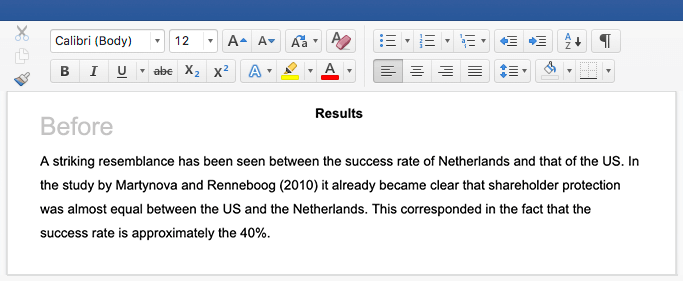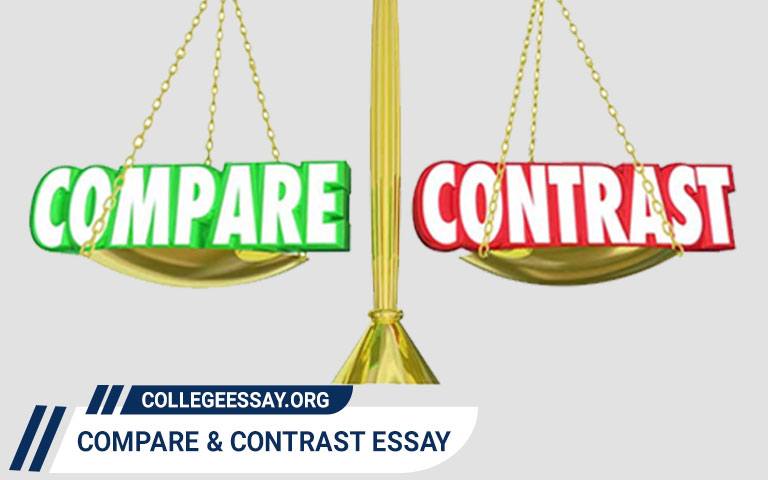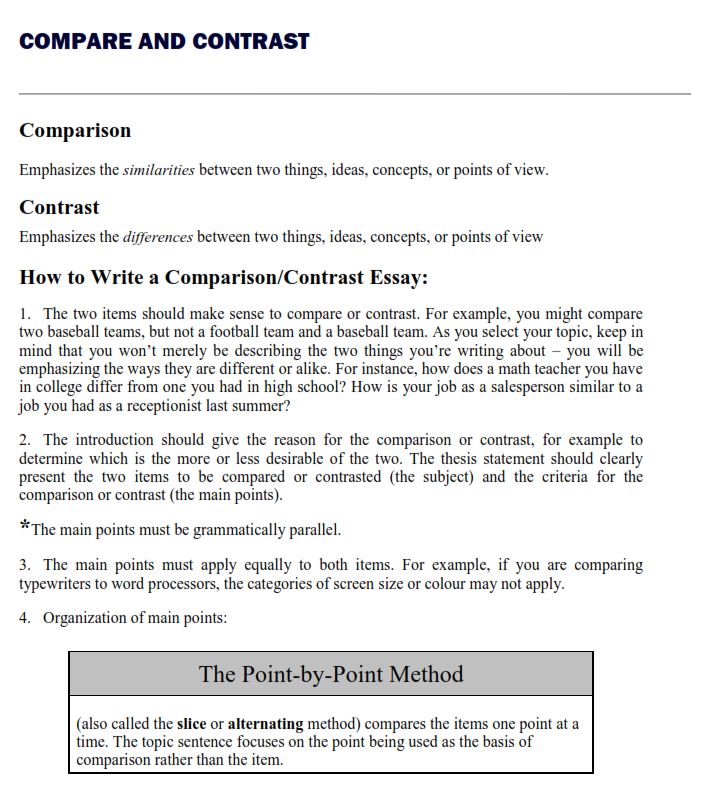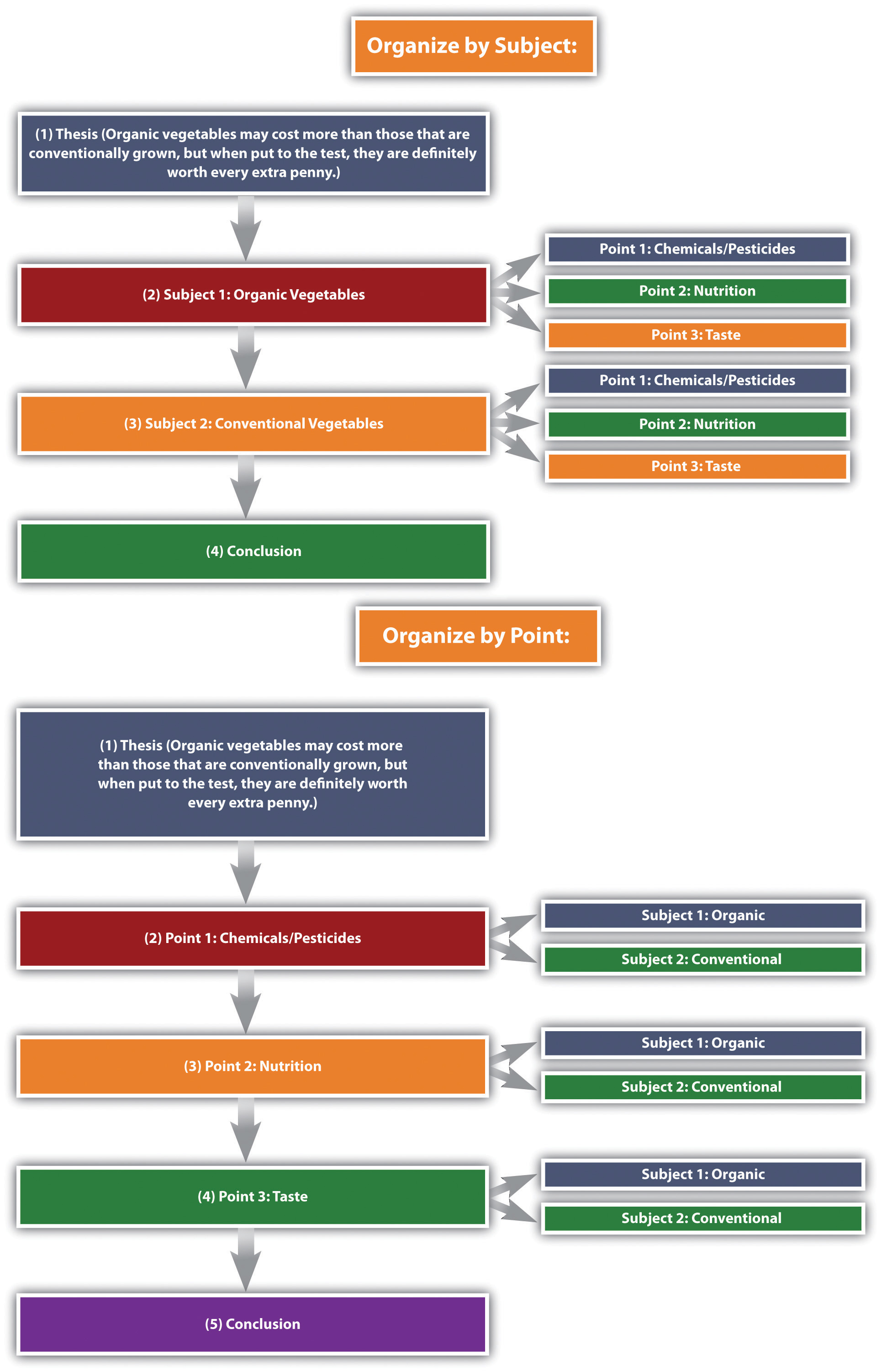
Comparing and contrasting is an important skill in academic writing. It involves taking two or more subjects and analyzing the differences and similarities between them.
Comparing and contrasting is also a useful approach in all kinds of academic writing: You might compare different studies in a literature review, weigh up different arguments in an argumentative essay, or consider different theoretical approaches in a theoretical framework.
Some essay prompts include the keywords “compare” and/or “contrast.” In these cases, an essay structured around comparing and contrasting is the appropriate response.
- Subject 1
- Point of comparison A
- Point of comparison B
- Subject 2
- Point of comparison A
- Point of comparison B
Table of contents
You’ll have to write a thesis statement explaining the central point you want to make in your essay, so be sure to know in advance what connects your subjects and makes them worth comparing.
- The alternating method, where you compare your subjects side by side according to one specific aspect at a time.
- The block method, where you cover each subject separately in its entirety.
In the block method, you cover each of the overall subjects you’re comparing in a block. You say everything you have to say about your first subject, then discuss your second subject, making comparisons and contrasts back to the things you’ve already said about the first. Your text is structured like this:

Usually, the essay format is provided in the guidelines and instructions but if not then use the basic essay format to structure your essay. According to the traditional outline, an essay should be divided among the following sections:
The objects or subjects you choose to compare should be the same, yet different in nature at the same time to draw a comparison. Brainstorm ideas that fascinate you or interest you and you know that the audience will like it as well.
Writing compare and contrast essays successfully means writing it in a proper and perfect manner. A writer cannot just present the raw information in the essay without an outline. The outline shapes and provides meaning to the entire essay.
We compare things in our daily life to make choices. Hypothetically, if a person has a limited budget and goes shopping, he would compare things and make choices that will best suit him.
How to Start a Compare and Contrast Essay?

Writing a compare and contrast essay is a task that almost every student gets for his academics. Instructors assign these types of essays to assess the student’s skills in writing, evaluating, analyzing, and differentiating objects.
To give our students a better understanding of compare and contrast essay concepts, we have gathered some useful examples.
After taking all the mandatory pre-writing steps, start writing your compare and contrast essay in the following manner.

Many assignments will invite you to make comparisons quite explicitly, as in these prompts.
Mouse over the example paragraph below to see how this approach works.
You might find yourself comparing all kinds of things in an academic essay: historical figures, literary works, policies, research methods, etc. Doing so is an important part of constructing arguments.
In the block method, you cover each of the overall subjects you’re comparing in a block. You say everything you have to say about your first subject, then discuss your second subject, making comparisons and contrasts back to the things you’ve already said about the first. Your text is structured like this:
Table of contents
Comparing and contrasting is an important skill in academic writing. It involves taking two or more subjects and analyzing the differences and similarities between them.
- The alternating method, where you compare your subjects side by side according to one specific aspect at a time.
- The block method, where you cover each subject separately in its entirety.
Comparing and contrasting is also a useful approach in all kinds of academic writing: You might compare different studies in a literature review, weigh up different arguments in an argumentative essay, or consider different theoretical approaches in a theoretical framework.

The body of the essay can be organized in one of two ways: by subject or by individual points. The organizing strategy that you choose will depend on, as always, your audience and your purpose. You may also consider your particular approach to the subjects as well as the nature of the subjects themselves
The organizational structure you choose depends on the nature of the topic, your purpose, and your audience.
There are two main organizing strategies for compare-and-contrast essays.
Given that compare-and-contrast essays analyze the relationship between two subjects, it is helpful to have some phrases on hand that will cue the reader to such analysis. See Table 10.3 “Phrases of Comparison and Contrast” for examples.
Writing at Work
Create an outline for each of the items you chose in Note 10.72 “Exercise 1” and Note 10.73 “Exercise 2”. Use the point-by-point organizing strategy for one of them, and use the subject organizing strategy for the other.
Many business presentations are conducted using comparison and contrast. The organizing strategies—by subject or individual points—could also be used for organizing a presentation. Keep this in mind as a way of organizing your content the next time you or a colleague have to present something at work.
- Department stores and discount retail stores
- Fast food chains and fine dining restaurants
- Dogs and cats
Comparing and contrasting is also an evaluative tool. In order to make accurate evaluations about a given topic, you must first know the critical points of similarity and difference. Comparing and contrasting is a primary tool for many workplace assessments. You have likely compared and contrasted yourself to other colleagues. Employee advancements, pay raises, hiring, and firing are typically conducted using comparison and contrast. Comparison and contrast could be used to evaluate companies, departments, or individuals.
“Making the move from elementary school to middle school may seem scary, but knowing what to expect can really help. Elementary school provides kids with the experiences they need to be ready for middle school. Even though moving on means adjusting to a new environment, some things, including many of the classmates who accompany you, will remain the same.”
- Discussing the similarities and differences between one side of the topic.
- Discussing the similarities and differences between the other side of the topic.
- Subject By Subject Method Example (PDF)
MyPerfectWords.com is a trusted and reputable company that provides legal essay writing services by drafting original content for our clients.
- Discussing the comparison/ similarities between the two sides/ topics in the first part.
- Discussing the contrast/ differences between the two sides/ topic in the second part.
Subject By Subject
“Elementary schools and middle schools have many traits in common. Typically, both are open five days a week for a set number of hours each day. Students sit at desks in classrooms and are expected to listen to and learn from their teachers. There is a set time for lunch. Each day, students are given homework assignments. Students take quizzes and tests. In all of these ways, middle school should feel somewhat familiar to new students.
Before submitting your essay, check for mistakes in punctuation, grammar, format, tone, vocabulary, syntax, etc. Make the required editings in this step and submit a well-written assignment.
- Select a topic -> To choose subjects to compare, make sure that they belong to the same category, and have some similarities to be compared. Choosing compare and contrast essay topics can be time-consuming, but it is an essential step in drafting an essay.
- Brainstorm ideas - Brainstorm similarities and differences you think can be used to make the comparison best. To make the brainstorming process easy, create a table or Venn Diagram to list similarities and differences.
- Research and gather information - Brainstormed ideas need strong facts to be proved right. Conduct research to gather evidence and facts to support your points.
- Develop a thesis statement - Analyze the gathered information to form a claim or argument.
- Draft an outline - No matter what the subject or type of the essay is, an outline is essential. Organize all the gathered material in the following sections before writing your essay:
- Introduction
- Body Paragraphs
- Conclusion
The high school essay is different from the college compare and contrast essay. It does not require that expert level of logical analysis from the students. Instead, it is just an opportunity for them to learn better.
